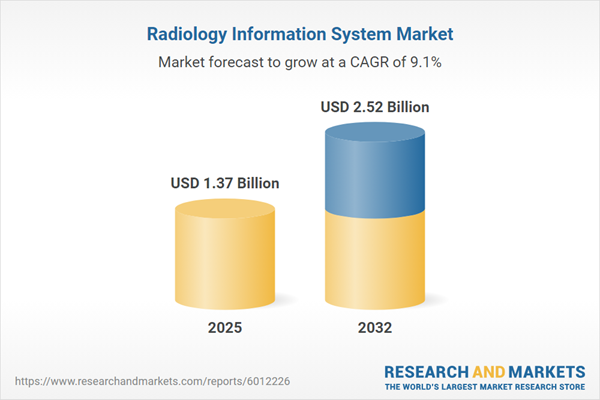Speak directly to the analyst to clarify any post sales queries you may have.
Radiology information systems play a transformative role in modern healthcare, accelerating clinical workflows and data sharing for sharper decision-making. As imaging and diagnostics become focal points in operational modernization, these technologies are redefining how care teams and executives achieve efficient, integrated delivery.
Market Snapshot: Radiology Information System Market Size and Trends
The global radiology information system (RIS) market stands at USD 1.25 billion in 2024 and is projected to reach USD 2.52 billion by 2032, advancing at a 9.10% CAGR. This growth reflects mounting pressure on healthcare organizations to modernize digital infrastructure and invest in automated clinical imaging solutions. Providers and vendors are closely evaluating RIS platforms based on their interoperability, potential to scale, and influence on patient outcomes. Advances in cross-system digital connectivity and unified imaging data management are propelling RIS adoption, improving operational agility and positioning the market as central to the future of diagnostic workflows across all care environments.
Scope & Segmentation of the Radiology Information System Market
This report is tailored for healthcare executives seeking to optimize investments in radiology information systems. It highlights strategic market segments, deployment options, and technology selections that align RIS capacity with organizations’ evolving care and business goals.
- Component: Modern RIS platforms consist of advanced imaging servers, high-performance diagnostic workstations, and comprehensive software that supports functions like image archiving, analytics, patient scheduling, interdisciplinary communication, and billing management. Professional services—consulting, workflow optimization, training, and technical support—enhance operational performance and long-term adoption success.
- Integration: Efficient RIS solutions connect seamlessly with electronic health records (EHRs) and hospital information systems to facilitate coordinated and continuous care. Adherence to DICOM and HL7 standards ensures broad interoperability. Both integrated and stand-alone RIS systems are used, supporting diverse clinical needs and deployment environments.
- Deployment: Organizations select between cloud-based and on-premise RIS deployments to meet unique regulatory, IT, and scalability demands. These choices influence long-term upgrade strategies and ensure alignment with compliance and future expansion priorities.
- End User: Hospitals, imaging centers, and clinics each require tailored RIS integration. Facilities prioritize data protection, workflow efficiency, and system compatibility to meet varying care delivery and administrative expectations, ensuring that RIS investments directly support their distinctive operational models.
- Regional Coverage: The report analyzes key regional markets—North America, Latin America, Europe, Middle East & Africa, and Asia-Pacific—spotlighting differences in adoption patterns, government reimbursement policies, and regional regulations that shape purchasing strategies around healthcare technology.
- Key Companies Analyzed: Competitive analysis covers major providers, including General Electric Company, Siemens Healthineers AG, Koninklijke Philips N.V., FUJIFILM Holdings Corporation, Agfa-Gevaert N.V., Carestream Health, Inc., Sectra AB, Intelerad Medical Systems, Infinitt Healthcare Co., Ltd., and RamSoft, Inc., offering varied technological expertise and global coverage.
Key Takeaways for Senior Decision-Makers
- Integrating advanced analytics and artificial intelligence capabilities within RIS streamlines workflows and sharpens diagnostic support for clinical teams.
- Ensuring robust interoperability between RIS, EHRs, and image repositories is vital for coordinated care and minimizing data silos across clinical operations.
- Cloud-native RIS deployments enable more flexible, scalable remote diagnostic capabilities and future-proof evolving organizational structures.
- Modular RIS design and adaptable licensing structures support phased upgrades, minimizing operational disruptions and optimizing capital investment cycles.
- Successful RIS procurement requires tailored approaches to privacy regulations and standards, resulting in customized implementations that meet complex healthcare demands.
Tariff Impact: Navigating Cost and Supply Chain Dynamics
Upcoming tariffs on medical imaging hardware in the United States—expected to take effect in 2025—are driving providers to reevaluate equipment investments and supply chain planning. Many are leveraging longer-term vendor agreements and enhanced cost controls to stabilize budgets and reduce volatility. The shift toward cloud-based subscription RIS models is accelerating, with organizations seeking to decrease dependency on physical hardware and build resilience against future market fluctuations.
Methodology & Data Sources
Findings in this report are based on executive interviews, broad market trend studies, and regulatory analysis. Rigorous validation methods have been used to ensure actionable accuracy for decision-makers in healthcare leadership roles.
Why This Report Matters
- Equips senior leadership with clear insights to assess, select, and manage RIS investments for digital health transformation.
- Anticipates integration, procurement, and compliance challenges, helping organizations navigate changing regulatory and industry standards.
- Supports long-term planning for risk reduction and continuous improvement in imaging and diagnostic infrastructure.
Conclusion
Radiology information systems provide organizations with tools to improve workflows and support patient-centered clinical strategies. This report enables healthcare executives to make informed technology decisions that align care and business objectives for the future.
Additional Product Information:
- Purchase of this report includes 1 year online access with quarterly updates.
- This report can be updated on request. Please contact our Customer Experience team using the Ask a Question widget on our website.
Table of Contents
3. Executive Summary
4. Market Overview
7. Cumulative Impact of Artificial Intelligence 2025
Companies Mentioned
The companies profiled in this Radiology Information System market report include:- General Electric Company
- Siemens Healthineers AG
- Koninklijke Philips N.V.
- FUJIFILM Holdings Corporation
- Agfa-Gevaert N.V.
- Carestream Health, Inc.
- Sectra AB
- Intelerad Medical Systems, Inc.
- Infinitt Healthcare Co., Ltd.
- RamSoft, Inc.
Table Information
| Report Attribute | Details |
|---|---|
| No. of Pages | 189 |
| Published | October 2025 |
| Forecast Period | 2025 - 2032 |
| Estimated Market Value ( USD | $ 1.37 Billion |
| Forecasted Market Value ( USD | $ 2.52 Billion |
| Compound Annual Growth Rate | 9.1% |
| Regions Covered | Global |
| No. of Companies Mentioned | 11 |









